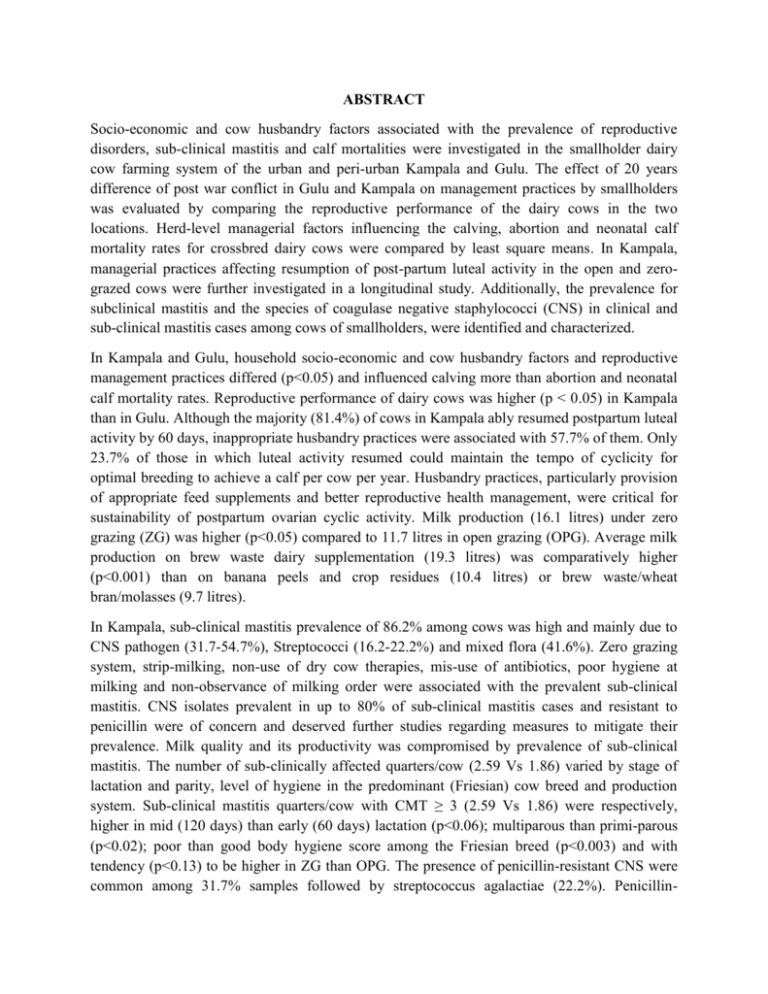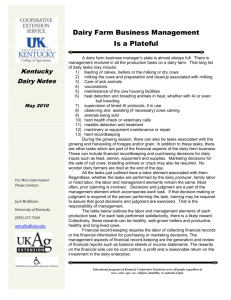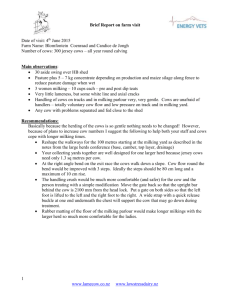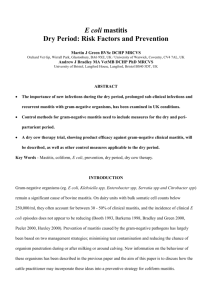ABSTRACT (Kanyima) final
advertisement

ABSTRACT Socio-economic and cow husbandry factors associated with the prevalence of reproductive disorders, sub-clinical mastitis and calf mortalities were investigated in the smallholder dairy cow farming system of the urban and peri-urban Kampala and Gulu. The effect of 20 years difference of post war conflict in Gulu and Kampala on management practices by smallholders was evaluated by comparing the reproductive performance of the dairy cows in the two locations. Herd-level managerial factors influencing the calving, abortion and neonatal calf mortality rates for crossbred dairy cows were compared by least square means. In Kampala, managerial practices affecting resumption of post-partum luteal activity in the open and zerograzed cows were further investigated in a longitudinal study. Additionally, the prevalence for subclinical mastitis and the species of coagulase negative staphylococci (CNS) in clinical and sub-clinical mastitis cases among cows of smallholders, were identified and characterized. In Kampala and Gulu, household socio-economic and cow husbandry factors and reproductive management practices differed (p˂0.05) and influenced calving more than abortion and neonatal calf mortality rates. Reproductive performance of dairy cows was higher (p ˂ 0.05) in Kampala than in Gulu. Although the majority (81.4%) of cows in Kampala ably resumed postpartum luteal activity by 60 days, inappropriate husbandry practices were associated with 57.7% of them. Only 23.7% of those in which luteal activity resumed could maintain the tempo of cyclicity for optimal breeding to achieve a calf per cow per year. Husbandry practices, particularly provision of appropriate feed supplements and better reproductive health management, were critical for sustainability of postpartum ovarian cyclic activity. Milk production (16.1 litres) under zero grazing (ZG) was higher (p˂0.05) compared to 11.7 litres in open grazing (OPG). Average milk production on brew waste dairy supplementation (19.3 litres) was comparatively higher (p˂0.001) than on banana peels and crop residues (10.4 litres) or brew waste/wheat bran/molasses (9.7 litres). In Kampala, sub-clinical mastitis prevalence of 86.2% among cows was high and mainly due to CNS pathogen (31.7-54.7%), Streptococci (16.2-22.2%) and mixed flora (41.6%). Zero grazing system, strip-milking, non-use of dry cow therapies, mis-use of antibiotics, poor hygiene at milking and non-observance of milking order were associated with the prevalent sub-clinical mastitis. CNS isolates prevalent in up to 80% of sub-clinical mastitis cases and resistant to penicillin were of concern and deserved further studies regarding measures to mitigate their prevalence. Milk quality and its productivity was compromised by prevalence of sub-clinical mastitis. The number of sub-clinically affected quarters/cow (2.59 Vs 1.86) varied by stage of lactation and parity, level of hygiene in the predominant (Friesian) cow breed and production system. Sub-clinical mastitis quarters/cow with CMT ≥ 3 (2.59 Vs 1.86) were respectively, higher in mid (120 days) than early (60 days) lactation (p˂0.06); multiparous than primi-parous (p˂0.02); poor than good body hygiene score among the Friesian breed (p˂0.003) and with tendency (p˂0.13) to be higher in ZG than OPG. The presence of penicillin-resistant CNS were common among 31.7% samples followed by streptococcus agalactiae (22.2%). Penicillin- resistant CNS species isolates, S epidermidis (85%) and S haemolyticus (15%) were found in 80% of CNS isolates and were associated with hand milking in all clinical and sub-clinical (CMT ≥ 4) mastitis cows in the Kampala area. The prevalence of both the udder adapted S epidermidis and the environment-adapted S haemolyticus was associated with malpractices during milking, but could also be due to imprudent use of antibiotics in the Kampala smallholder dairy production system. In conclusion, the studies established that reproductive performance and milk production, of crossbred dairy cows in Kampala were better (p ˂ 0.05) than in Gulu, and attributed to the socioeconomic dissimilarities in husbandry practices linked to the difference in post-civil war social stability of the two urban settings. The resumption of postpartum ovarian function in crossbred dairy cows of Kampala as indicated by luteal activity, was normally occurring (56 days) and comparable to other cows elsewhere although its sustenance in the majority was hampered by sub-optimal husbandry factors and practices on farms. Zero-grazing, poor environmental hygiene and on-farm malpractices at milking such as poor hygiene and strip hand milking techniques or imprudent use of antibiotics were associated with high prevalence of sub-clinical mastitis and presence of CNS species resistant to penicillin among clinical and severe sub-clinical mastitis cases.






